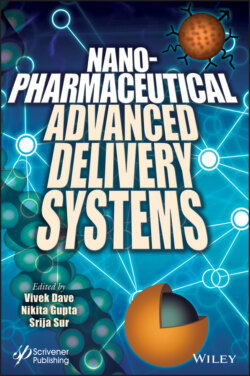Читать книгу Nanopharmaceutical Advanced Delivery Systems - Группа авторов - Страница 22
1.3.6 Crystalline Mesophases
ОглавлениеMost of the drugs present in the market have prevalent problems such as poor solubility, low bioavailability, drug development cost, and time taken into consideration for developing and formulating a novel drug delivery system. One of the primary methods of preparation of crystalline mesophases was selected based upon the shape, state, and form of drug molecules. Current procedures for preparing liquid crystalline mesophases have been extensively considered for over a couple of decades for improving solubility and controlled drug release rate. Crystalline mesophases are also categorized into liquid crystals, plastic crystals, and confirmatively dispersed crystals according to their transcription, orientation, and concordances that constitute a specific condensation state [70]. Disordering solids typically associated with amorphous substances have received a major focus on pharmaceutical products. The practical benefits of CMs including increased solubility in nanoparticles and greater stability for protein drugs obtained by mixing protein can be significant in amorphous condition. On the other hand, thermodynamically less stable amorphous compounds than the corresponding crystalline state can undergo physical and chemical modifications and therefore decrease the shelf life. Chemical reactivity levels of amorphous vs. crystalline materials are known for many structures, where the rates of degradation are significantly higher with amorphous materials [71-73]. CMs are mainly classified into lyotropic and thermotropic. Thermotropic liquid crystals show mesophase formation when temperature affects the transition, while the change in solvent in a mixture of components at a particular temperature forms lyotropic crystals. The availability of fluid crystals as medicines is a broad area for research. The demand for the application of drug delivery nanoparticles (cubosomes and hexosomes), in particular lyotropic crystal, has been high in the last few years. Drug delivery based on nanoparticles promises the choice of drugs to be effective, regulated, and targeted [74].
Table 1.2 Differences between SMEDDS, SEDDS, and SNEDDS.
| S. No. | Property | SMEDDS | SEDDS | SNEDDS |
| 1. | Size | <250 nm | >300 nm | <100 nm |
| 2. | Appearance | Optically clear | Turbid | Optically clear |
| 3. | Hydrophilic–lipophilic balance (HLB) value | >12 | <12 | >12 |
| 4. | Classification of lipid-based drug delivery system | Type IIIB | Type II | Type IIIB |
| 5. | Concentration of oil | >20% | 40-80% | >20% |
| 6. | Concentration of surfactant | 40-80% | 30-40% | 40-80% |
| 7. | Material | Oil, surfactant, and co-solvents (both water soluble and insoluble excipients) | Oil water insoluble surfactant | Oils without surfactants (e.g., tri-, di-, and monoglycerides) |
| 8. | Characteristics | SMEDDS create with aqueous soluble elements | SEDDS create without aqueous soluble elements | Nondispersing requires digestion |
| 9. | Advantages | Clear dispersion, absorption of drug without digestion | Improbable loss of solvent, capacity on dispersion | Good solvent capacity for many drug formulations. |
| 10. | Disadvantages | Less easily digested | Turbid o/w dispersion | Poor solvent capacity until drug is lipophilic |
Cubosomes and hexosomes have generated great attention as they are the first to have molecular, multilevel, mesophasic, and nanoparticle observed structural compounds. They can be administrated through various routes thus providing versatility in the administration of various drugs. Internal structure defined before dispersion by liquid crystal mesophases of amphiphiles offers complex topologies; they can carry a higher volume of drug with long-term release [75]. Size ranges vary in the nanometer range, which allows similar surfactant to uniformly distribute and prevent aggregation. Since it possesses the curvature in the internal structure of crystalline mesophases, large volume of the drug can be loaded, which increases the potential for drug targeting [76, 77]. Due to the amphiphilic nature of liquid crystal forming lipid (polar head and lipophilic tail), they arrange themselves into a cubic or hexagonal phase, which is thermodynamically stable. Therapeutic applications of liquid crystal nanoparticles (cubosomes and hexagonal) are associated with the drug, route of delivery, formulation, and physiochemical properties such as increased molecular weight, the different polarity of drug molecule, compatibility issue, enzymatic degradation, and reduced toxicity.
